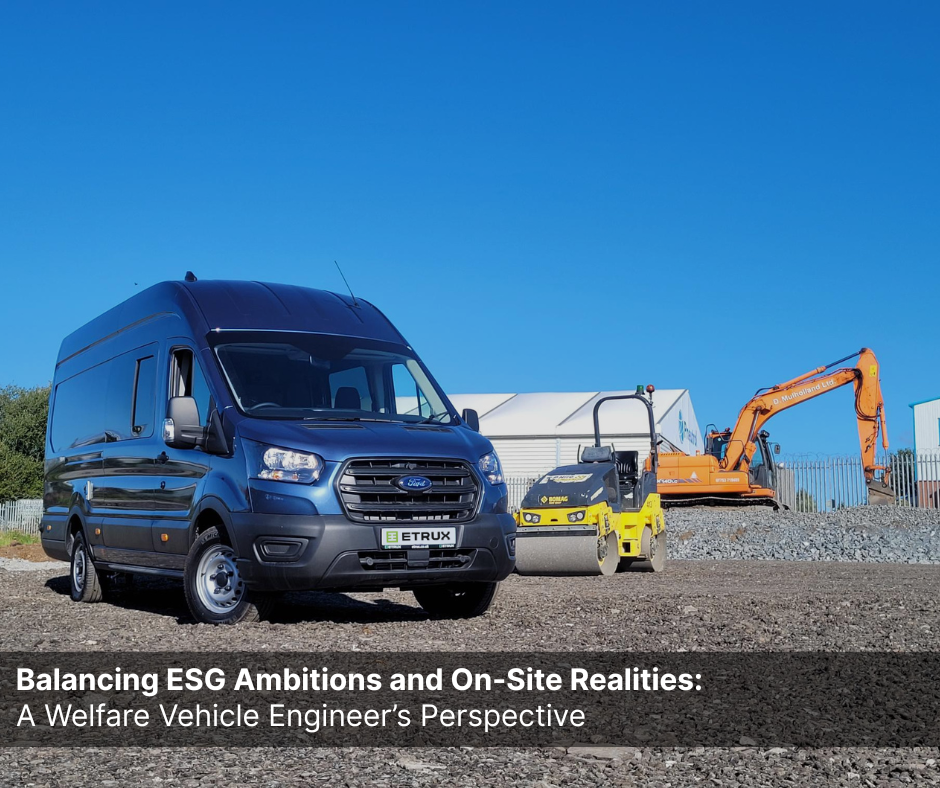Buying or Renting Welfare Vehicles? Here’s What Really Matters.
By Gareth Pinkerton – Head of Engineering, ETRUX
Let’s be honest: welfare vehicles rarely get the attention they deserve.
They’re not the flashiest part of the fleet, and they’re not where most firms start when it comes to investing in ESG, operational upgrades, or site safety. But get them wrong, and it doesn’t take long for the knock-on effects to show up — in downtime, unhappy site teams, safety breaches or unexpected costs.
As someone who’s worked with construction buyers, fleet leads and operations managers for years, I know the decisions around welfare vehicles are rarely simple. Whether you’re buying new or renting short-term, there’s a tightrope to walk between compliance, value, comfort, and operational reliability.
So, let’s cut through the noise. Here are the five things that matter most when choosing the right welfare vehicle setup — from someone who engineers them for a living, but understands the commercial pressures you’re up against.
1. Fitness for Purpose: Not All Welfare Units Are Equal
It sounds basic, but you’d be surprised how often we see welfare vehicles deployed that simply don’t suit the site or the job.
Think about:
• Crew size: are you trying to squeeze six into a four-person space?
• Site conditions: muddy access routes, inner-city ULEZ zones, or remote sites all demand different setups.
• Usage pattern: will it stay static most of the day or be mobile across multiple sites?
Too many buyers start with the price tag, not the problem they’re trying to solve. But a poorly suited vehicle creates frustration, inefficiency, and sometimes safety issues. Start with the real world needs, then match the solution.
2. Compliance & Safety: A Must-Have, Not a Nice-to-Have
You wouldn’t send scaffolding out without inspection — the same logic should apply to your welfare fleet.
HSE requirements are tightening, and large contractors are under pressure to prove their commitment to worker wellbeing. So your welfare vehicle needs to stand up to scrutiny.
Key questions:
• Is it compliant with the latest guidance on sanitation, break areas, drying space, and rest facilities?
• Are electrical and gas systems properly certified?
• Is the build anti-vandal and theft-resistant?
• Can it safely support BEV infrastructure, if applicable?
Buying from a recognised convertor — particularly an OEM-approved one like a Ford Pro Convertor — ensures these questions are answered from day one. Compliance isn’t just about paperwork — it’s about risk mitigation.
3. Total Cost of Ownership (TCO): It’s More Than the Purchase Price
If you’re comparing quotes based on sticker price alone, you’re missing the bigger picture.
True value comes from:
• Lower maintenance and downtime
• Better energy efficiency (especially with BEV)
• Fewer retrofit costs
• Longer operational life
• Stronger residual value
Poor-quality conversions often cost less upfront — but end up costing more in service calls, site delays, or lost productivity.
Whether you’re renting or buying, ask your supplier to walk you through the whole-life cost model. A good partner won’t just sell you a van — they’ll help you make a financially smart decision.
4. Quality of Conversion & OEM Alignment: Trust the Badges
There are plenty of converters out there. But only a handful have the technical and process discipline to deliver conversions that truly integrate with OEM platforms.
That’s where status like Ford Pro Convertor becomes more than a label.
It means:
• Vehicles are converted under strict technical guidelines
• Warranty integrity is preserved
• Systems (especially on BEV platforms) are properly aligned
• You get peace of mind with aftersales support
We’ve seen horror stories where warranty claims were rejected because conversions weren’t done properly. Don’t take that risk — go with a convertor that’s accredited, accountable, and technically aligned with your fleet’s OEMs.
5. Support, Scalability & Service: Your Partner Matters
Welfare vehicles are operational assets. When one’s down, you feel it.
Whether you’re buying a dozen new units or renting five for a temporary project, your supplier needs to act like a partner — not just a vendor.
That means:
• Clear lead times
• Transparent servicing schedules
• Responsive support teams
• Scalable fleet capacity if your project scope changes
When you’re working with large construction projects, you need confidence that your welfare setup won’t become the weak link.
Final Thoughts: The Hidden ROI of Doing It Right
In the end, welfare vehicles are more than a tick-box on your site checklist. They’re a reflection of how your business treats its people, its responsibilities, and its operations.
The consequences of getting it wrong are real — so are the benefits of getting it right. Safer, happier sites. Fewer breakdowns. Smoother compliance audits. And yes, better ESG performance.
Whether you’re buying or renting, we can help you think through the right solution — built around how you work, and what your people need


